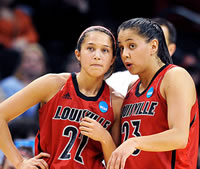Shooting for the
Stars with the Schimmel Sisters
written by Heather
Van Mullem, PhD, Lewis-Clark State College
 In
recent years, women of ethnic minority status have made huge
strides in being recognized for their athletic endeavors.
The speed and power of sprinter Wilma Rudolph and the high-flying
sharp shooting of Cheryl Miller, paved the way for the dominating
play of the William's sisters, the acrobatic elegance of Gabby
Douglas, and the powerful swing of Michelle Wie. However,
as promising as these changes may be, one minority group in
particular seems to have fallen by the wayside. While the
media has increased its coverage of the successes of female
athletes of ethnic minority status, Native American female
athletes have consistently been ignored (King, 2005). Battling
racism, sexism, and classism, they "have been silenced by
being suppressed, excluded, and misrepresented at every level
of social interaction and have been placed at the margins
by the dominant culture in society and sport" (Smith, 1992,
p. 229). In
recent years, women of ethnic minority status have made huge
strides in being recognized for their athletic endeavors.
The speed and power of sprinter Wilma Rudolph and the high-flying
sharp shooting of Cheryl Miller, paved the way for the dominating
play of the William's sisters, the acrobatic elegance of Gabby
Douglas, and the powerful swing of Michelle Wie. However,
as promising as these changes may be, one minority group in
particular seems to have fallen by the wayside. While the
media has increased its coverage of the successes of female
athletes of ethnic minority status, Native American female
athletes have consistently been ignored (King, 2005). Battling
racism, sexism, and classism, they "have been silenced by
being suppressed, excluded, and misrepresented at every level
of social interaction and have been placed at the margins
by the dominant culture in society and sport" (Smith, 1992,
p. 229).
Although mainstream society is seldom exposed to the performance
of Native Americans in sports, sports have played an important
role in the evolution of Native American culture, influencing
many phases of their lives (Oxendine, 1988). Basketball appears
to have become one of the most popular sports (Cheska, 1984)
and is interwoven into the fabric of Native American culture.
Described as an "all-consuming passion" by some (NPR, 2003)
and as a "drug" by others (Smith, 1991), the sound of a basketball
bouncing has been likened to the beating of a warrior's drum
(Donahue, 1997). For years, Native American basketball tournaments
have been immensely popular, allowing Native Americans to
compete in the sport many years after their high school or
college eligibility is over. In a fictional story, the author
Welch questioned who the true inventor of basketball really
was, implying that the game was modeled after the traditional
Indian game of hoop and pole (Donahue, 1997).
 Today,
Native American athletes continue to play and succeed in sports
although their efforts are seldom recognized. Unfortunately,
"athletic skills developed on American Indian land are often
contained within its boundaries" (Selena, 2001, p. 1). What
little media coverage Native American female athletes have
received, has tended to focus on failures rather than highlight
successes. With the absence of their stories and thus their
voice, the media has perpetuated the belief that if Native
American female athletes do exist, they must struggle to be
successful. Unfortunately, this practice of primarily recognizing
the negative stories, or providing no stories at all, has
served to reinforce incorrect stereotypes that Native American
female student-athletes are not or cannot be successful in
mainstream sports (King, 2005). Today,
Native American athletes continue to play and succeed in sports
although their efforts are seldom recognized. Unfortunately,
"athletic skills developed on American Indian land are often
contained within its boundaries" (Selena, 2001, p. 1). What
little media coverage Native American female athletes have
received, has tended to focus on failures rather than highlight
successes. With the absence of their stories and thus their
voice, the media has perpetuated the belief that if Native
American female athletes do exist, they must struggle to be
successful. Unfortunately, this practice of primarily recognizing
the negative stories, or providing no stories at all, has
served to reinforce incorrect stereotypes that Native American
female student-athletes are not or cannot be successful in
mainstream sports (King, 2005).
Recently however, a shift in media presence and coverage
of Native American female athletes occurred as the Schimmel
sisters, Shoni and Jude, exploded onto the national sports
scene. Members of the Confederated Tribes of the Umatilla
Indian Reservation in Oregon, Shoni and Jude played for the
Louisville Cardinal Women’s Basketball team, which contended
for the 2013 NCAA Division-I National Basketball Championship
(Vopel, 2013, April 2).
The Schimmel sisters have been celebrated for their exciting,
fun, free-wheeling style of play, tabbed as "rez ball" (Longman,
2013, April 6). This style of play, the way it has contributed
to the team's success, and their ethnicity has captivated
women's basketball fans everywhere. One of their teammates
shared,
We're witnessing something that hasn’t been done
in women’s basketball...we go anywhere in the country,
and we've got more fans in red than the other team has on
their floor. I think it goes to show Shoni and Jude's character.
They're special people, and what they're doing for the whole
Native American culture is very special. And they're kind
of showing them what can be done, just if you jump out on
a leap of faith. That's what Shoni and Jude did." (Hays,
2014)
Increasingly the mainstream media is recognizing the Schimmel
sisters' talents and successes. As Hays (2014) documents,
their fan base is extensive and diverse. Crowds gather to
watch them play. A substantial proportion of their fans are members of different Native American tribes who travel to support their efforts on the hardwood. Hays (2014) argues,
"[Shoni] Schimmel's greatest social impact comes in representing
Native Americans too rarely seen on such sporting stages..."
If you haven't seen the Schimmels in action, consider tuning
in to the 2014 NCAA Women’s Basketball Tournament. These
young women can play and display a level of talent and athleticism
at the highest level of competitive collegiate women's basketball.
In addition to playing an exciting, up-tempo brand of basketball,
they provide a glimpse into the talent and athleticism of
Native American athletes too often ignored by mainstream media.
references
Biography: Heather Van Mullem is an Associate Professor in
the Health & Kinesiology Program at Lewis-Clark State
College in Lewiston, ID. A former college basketball player
and coach, she received her Ph.D from the University of Kansas
in Sports Studies with an emphasis in Sport Psychology and
Sport Sociology. In addition, she completed a Graduate Certificate
in Women’s Studies.
(back
to pelinks4u homepage) |




 In
recent years, women of ethnic minority status have made huge
strides in being recognized for their athletic endeavors.
The speed and power of sprinter Wilma Rudolph and the high-flying
sharp shooting of Cheryl Miller, paved the way for the dominating
play of the William's sisters, the acrobatic elegance of Gabby
Douglas, and the powerful swing of Michelle Wie. However,
as promising as these changes may be, one minority group in
particular seems to have fallen by the wayside. While the
media has increased its coverage of the successes of female
athletes of ethnic minority status, Native American female
athletes have consistently been ignored (King, 2005). Battling
racism, sexism, and classism, they "have been silenced by
being suppressed, excluded, and misrepresented at every level
of social interaction and have been placed at the margins
by the dominant culture in society and sport" (Smith, 1992,
p. 229).
In
recent years, women of ethnic minority status have made huge
strides in being recognized for their athletic endeavors.
The speed and power of sprinter Wilma Rudolph and the high-flying
sharp shooting of Cheryl Miller, paved the way for the dominating
play of the William's sisters, the acrobatic elegance of Gabby
Douglas, and the powerful swing of Michelle Wie. However,
as promising as these changes may be, one minority group in
particular seems to have fallen by the wayside. While the
media has increased its coverage of the successes of female
athletes of ethnic minority status, Native American female
athletes have consistently been ignored (King, 2005). Battling
racism, sexism, and classism, they "have been silenced by
being suppressed, excluded, and misrepresented at every level
of social interaction and have been placed at the margins
by the dominant culture in society and sport" (Smith, 1992,
p. 229). Today,
Native American athletes continue to play and succeed in sports
although their efforts are seldom recognized. Unfortunately,
"athletic skills developed on American Indian land are often
contained within its boundaries" (Selena, 2001, p. 1). What
little media coverage Native American female athletes have
received, has tended to focus on failures rather than highlight
successes. With the absence of their stories and thus their
voice, the media has perpetuated the belief that if Native
American female athletes do exist, they must struggle to be
successful. Unfortunately, this practice of primarily recognizing
the negative stories, or providing no stories at all, has
served to reinforce incorrect stereotypes that Native American
female student-athletes are not or cannot be successful in
mainstream sports (King, 2005).
Today,
Native American athletes continue to play and succeed in sports
although their efforts are seldom recognized. Unfortunately,
"athletic skills developed on American Indian land are often
contained within its boundaries" (Selena, 2001, p. 1). What
little media coverage Native American female athletes have
received, has tended to focus on failures rather than highlight
successes. With the absence of their stories and thus their
voice, the media has perpetuated the belief that if Native
American female athletes do exist, they must struggle to be
successful. Unfortunately, this practice of primarily recognizing
the negative stories, or providing no stories at all, has
served to reinforce incorrect stereotypes that Native American
female student-athletes are not or cannot be successful in
mainstream sports (King, 2005).